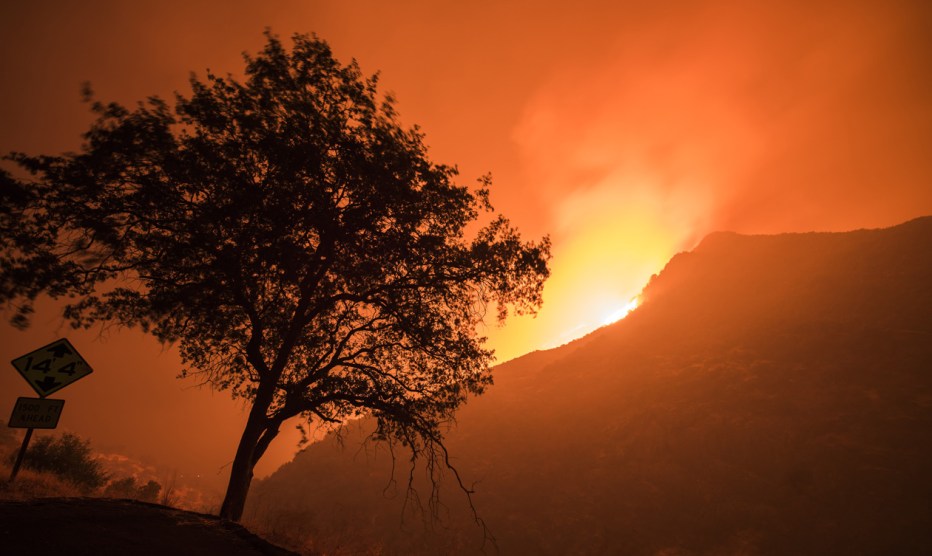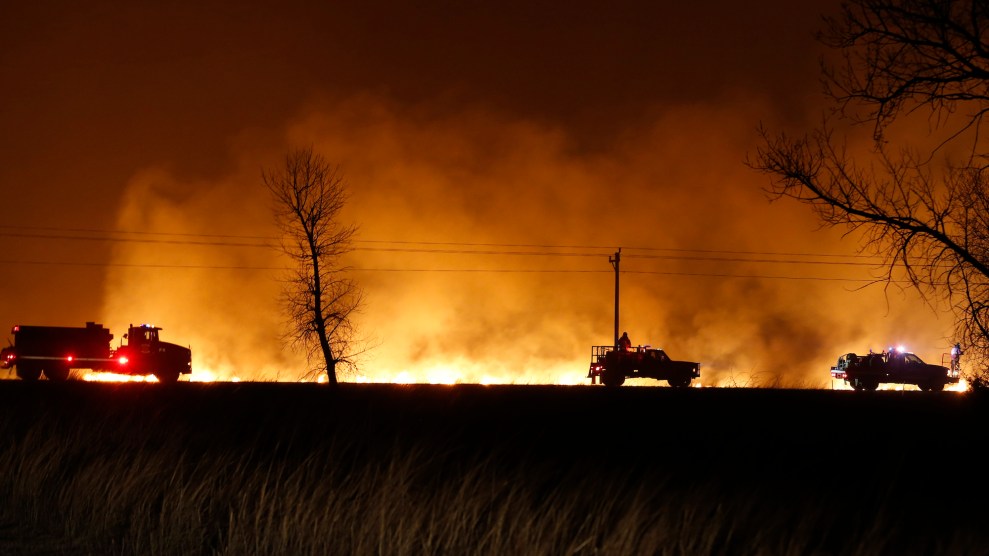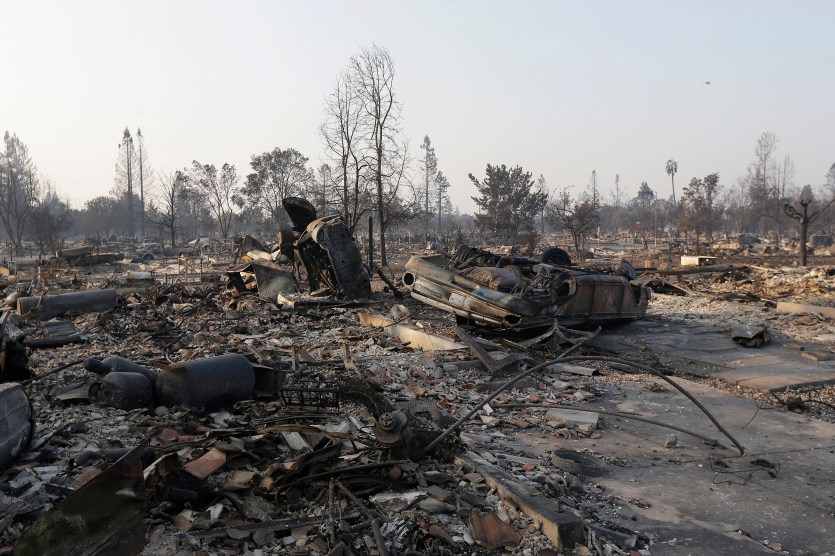
A car lies upside down at the site of a home destroyed by fires in Santa Rosa, Calif., Wednesday, Oct. 11, 2017.Jeff Chiu/AP
Update, October 15, 8:50 a.m.
On Sunday morning, firefighters had made progress in further containing the fires. Officials in the city of Napa told the San Francisco Chronicle that the blazes in the area were “not getting worse,” and Cal Fire officials said they expected full containment in Sonoma County by Friday. Rain is also expected toward the end of next week.
Update, October 14, 8:45 p.m. PDT:
The winds that earlier today had fanned the flames of the Nuns fire in Sonoma have since died down, the Los Angeles Times reports. Still, that fire measured 46,000 acres and was only 10 percent contained Saturday evening, and more than a dozen other blazes were still going strong. The Tubbs fire, which earlier this week was the largest, is now about 35,000 acres and 44 percent contained. Five more fire victims were identified today, bring the death toll to 40.
Update, October 14, 9:20 a.m. PDT:
On Saturday morning, firefighting crews fought to protect the historic towns of Calistoga and Sonoma from the blazes, the San Francisco Chronicle reported. The Nuns fire, which threatened Sonoma, grew and burned homes outside the town center as winds picked up, even as firefighters worked to contain some of the other fires. The death toll from the fires rose to 35.
Update, October 13, 4:20 a.m. PDT:
By Friday afternoon, authorities had tallied 33 confirmed deaths from the current fires, according to the Los Angeles Times. Though these deaths are spread across multiple fires, it’s worth noting that the total number significantly exceeds any individual fire event in California history, that the fires remain largely un-contained, and that the search for remains continues in already burned-out areas. Three of the fires currently burning are already listed among the state’s top 20 most deadly wildfires. For comparison, the 1991 Oakland firestorm—responsible for burning more than 2,800 homes—killed a total of 25 people.
Into the weekend, the return of high winds could potentially complicate efforts to contain and extinguish the fires. The National Weather Service extended a Red Flag Warning midday Friday, in effect from Friday evening through Saturday night for most of the affected areas. Gusts could potentially reach 40 mph during the overnight hours.
NEW: Red Flag Warning extended to the North Bay Valleys from late Friday & into Saturday. North Bay Valley locations with the highest threat include Napa Valley & from the City of Sonoma northward along Highway 12. #CaliforniaWildfires #NorthBayFires pic.twitter.com/uSmP0X8BPU
— NWS Bay Area (@NWSBayArea) October 13, 2017
Meanwhile, air quality throughout the northern parts of the San Francisco Bay Area has reached the “hazardous” rating on the EPA’s Air Quality Index scale. As of 4:20 p.m. on Friday, Napa, California, reported a PM2.5 index of 303, six times higher than the EPA’s “good” air quality rating.
Update, October 13, 10:05 a.m. PDT:
Overnight, authorities revised the total number of deaths directly linked to the Northern California firestorm to 31. Firefighters now have about 25 percent containment over the Tubbs fire according to Cal Fire, which has killed 17, making it the most deadly of all the fires currently burning. Sonoma County officials have also lowered the number missing from 400 to 355, according to the San Francisco Chronicle. In total, the fires have burned more than 221,000 acres of land, an area about seven times the size of San Francisco.
Hauntingly, the Los Angeles Times reported on Friday that the average age of the victims identified so far in Sonoma and Napa counties was 79. The oldest victim currently identified was 100, and the youngest was 57.
“The bulk of them are in their 70s and 80s, so there is that commonality,” said Sonoma County Sheriff Rob Giordano at a news briefing, according to the Times.
Update, October 12, 2:15 p.m. PDT:
The death toll from California’s historic wildfires now stands at 29. At least 15 people have died in Sonoma County, adding to eight in Mendocino County, four in Yuba County, and two in Napa County.
Officials expect that number to rise as they continue to search through the more than 3,000 structures that have been destroyed by the fires. Santa Rosa Mayor Chris Coursey said at a Thursday press conference that, in his city alone, an estimated 2,834 homes have been lost to the firestorm, according to the San Francisco Chronicle.
By Thursday afternoon, the number of missing in Sonoma County alone had increased to 400, according to the Washington Post.
Meanwhile, Governor Jerry Brown said that he plans to visit the affected areas very soon.
“Our focus is on getting resources where they’re needed most, not pulling them away for photo-ops with the governor,” said a spokesperson for Governor Brown.
Update, October 12, 10:15 a.m. PDT:
Authorities revised the total death toll from the current Northern California firestorm to 23 overnight. Of these, at least 11 have been tied directly to the Tubbs Fire, making it one of the single deadliest fires in California history. Burning in both Napa and Sonoma Counties, the Tubbs fire has so far charred more than 34,000 acres. Perhaps because the anticipated winds did not emerge on Wednesday night, Cal Fire now reports about 10 percent containment on the Tubbs Fire.
However, the Sonoma County Sheriff’s Department is still working to track down 285 missing people, and most school districts in the affected areas are still closed. Air quality throughout most of the San Francisco Bay area remains unhealthy:
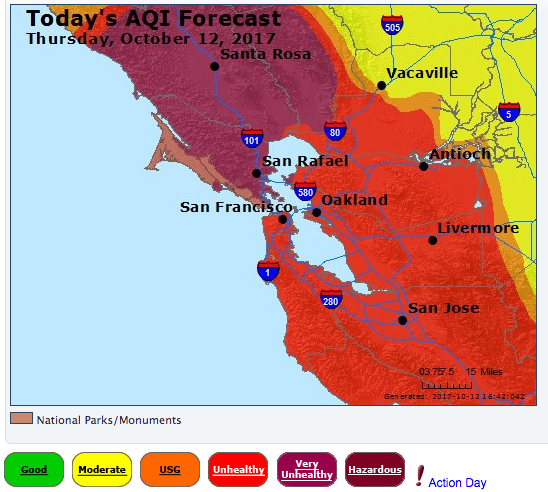
Air Quality Forecast for October 12, 2017. (BAAQMD)
The San Francisco Chronicle reported early on Thursday how Sonoma County Officials opted not to send a mass alert to cellphones on Sunday night, as the fires began to spread through densely populated areas. As the Chronicle reports, county officials worried that “doing so might create widespread panic and hinder the ability of first responders to combat the blazes.” Had the alert gone out, it would have notified people across a wide geographic area, including many not necessarily in the fire’s path. Officials pointed to a June incident in Southern California, when an “evacuate now” message was sent to several thousand people, prompting local police and fire departments in unaffected areas to tell residents that the message did not apply to them.
The below was shot earlier this week by a Sonoma County Sheriff’s deputy:
Video of conditions deputies & fire personnel facing in battling wildfires that have already killed 17 in California https://t.co/IV6m1678Ez pic.twitter.com/AkbsP8IiEJ
— WPLG Local 10 News (@WPLGLocal10) October 11, 2017
Update, October 11, 5:15 p.m. PDT: The San Francisco Chronicle reports 380 are still missing in Sonoma County as of earlier this afternoon; the death toll is still 21. The fires show no signs of abating and have still barely been contained. A red flag warning goes into effect tonight for much of the Bay Area; the National Weather Service recently added the Santa Cruz Mountains, south of San Francisco, as well as large swaths of the rest of northern California, to that warning.
Drone video shows neighborhoods reduced to ash and rubble. Read more about California's devastating wildfires here: https://t.co/BQX1Mu31E3 pic.twitter.com/MdwCHZGwke
— AP West Region (@APWestRegion) October 11, 2017
Air quality continues to reach unhealthy levels in much of the Bay Area, and is expected to worsen in some places tomorrow. The Oakland Raiders cut its practice short today due to air pollution, and San Francisco International Airport was forced to cancel 80 flights today due to the haze.
Update, October 11, 12:00 p.m. PDT: The death toll from the fires now stands at 21, the Associated Press reports.
Update, October 11, 10:55 a.m. PDT: The death toll from northern California’s fires has risen to 17 as the blazes in Sonoma and Napa counties now encompass nearly 90,000 acres—or 140 square miles. The Atlas fire is 3 percent contained, while the Nuns and Partrick fires are each 2 percent contained; the Tubbs fire is zero percent contained. There are now at least 22 wildfires across the state, and harrowing images of their destruction continue to surface:
The Atlas fire has moved west, prompting Gov. Jerry Brown to issue a state of emergency in Solano County—in addition to the emergencies already proclaimed in Sonoma, Napa, and Yuba counties. Some Solano County residents were forced to evacuate last night, and the city of Fairfield is on alert, as wind gusts are expected there at 11 a.m.
Sonoma County has created a map of the extent of its fires, using GIS data.
A red flag warning—indicating wind gusts that may add fuel to the current fires and perhaps spark new ones—is still being issued by the National Weather Service for large swaths of the eastern and northern Bay Area, from 5 p.m. today to 5 p.m. tomorrow.
UPDATE: Gusts expected to fuel #WineCountyFires that have killed 17. https://t.co/CldQK3l1Mf pic.twitter.com/fD73KQVSIg
— San Francisco Chronicle (@sfchronicle) October 11, 2017
The Chronicle reports that, according to Sonoma County Sheriff Rob Giordano, 670 people have been reported missing in Sonoma County, of which 110 have been found safe. A lack of cell service due to damaged cell towers has contributed to most of the missing persons reports. The excavations that were set to begin last night in Sonoma County haven’t yet begun.
On the public health front, most of California is still experiencing at least a moderate amount of air pollution. The Chronicle reports that students in Richmond and Hercules have reported respiratory irritation due to heavy smoke. Air quality is worst in Vacaville, a city of 100,000 northeast of the Bay, and in the area northwest of Reno, Nev. Residents of Sonoma and Napa counties have been advised to boil whatever water they consume.
The San Jose Mercury News reports that downed PG&E power lines and exploding electrical transformers have been linked to the fires.
Update, October 10, 4:20 p.m. PDT: Multiple outlets report that more than 180 people are missing—up from 150 earlier today. Sonoma County Sheriff Rob Giordano says a team of police officers will begin excavating for victims possibly buried in Santa Rosa’s rubble this evening.
Update, October 10, 2:25 p.m. PDT: Vice President Mike Pence announced this morning President Donald Trump’s approval of a “major disaster” declaration for the state of California, allowing FEMA to assist with the emergency. With two more fatalities confirmed by the Sonoma County sheriff’s office, the death toll has risen to 15. More than 150 people are still missing. The National Weather Service has issued yet another red flag warning—signaling wind gusts and low humidity, both of which were major factors in the development of the current fires—for parts of the Bay Area Wednesday through Thursday, indicating the as yet uncontained fires may worsen later this week.
LATEST: VP Pence announces that Pres. Trump has approved a major disaster declaration for the state of California due to wildfires. pic.twitter.com/x9eAs9PT5d
— ABC News (@ABC) October 10, 2017
At 2 p.m., the Santa Rosa Police Department urged all residents of the city’s Oakmont neighborhood to leave immediately, due to the “rapidly approaching” Nuns fire:
UPDATE: #NunsFire is rapidly approaching Oakmont. Oakmont is still under mandatory evacuation – all residents must leave now!
— Santa Rosa Police (@SantaRosaPolice) October 10, 2017
The EPA still classifies the air quality in much of northern California as “unhealthy” or “very unhealthy,” and the Bay Area Air Quality Management District has issued a “spare the air” alert for Tuesday and Wednesday, urging residents to refrain from driving and otherwise polluting.
The San Francisco Chronicle is keeping a list of wineries that have been damaged by the fires:
List of wineries damaged in the Wine Country fires: https://t.co/P4UWrHOCAt pic.twitter.com/HatUvNSCy1
— San Francisco Chronicle (@sfchronicle) October 10, 2017
Update, October 10, 10:25 a.m. PDT: The death toll from the northern California fires has risen to 13, according to the Chronicle, with an additional 150 people reported missing. Approximately 100 people are injured, many suffering major burns. One person in rural Yuba County, north of Sacramento, died trying to flee a fire by car, becoming trapped in the flames.
The Tubbs and Atlas fires still cover more than 50,000 acres with no signs of containment, and the Nuns fire—also in Sonoma County—has grown to 5,000 acres, threatening the previously unscorched neighborhood of Oakmont in Santa Rosa. Mendocino County’s Redwood and Potter fires are 21,000 acres. Most of the rest of northern California’s more than 15 fires have been partially contained.
Air quality around the Bay Area worsened overnight; the EPA has classified the air in San Francisco and much of northern California as “unhealthy.” Much of the rest of the state is also experiencing at least a moderate amount of air pollution.
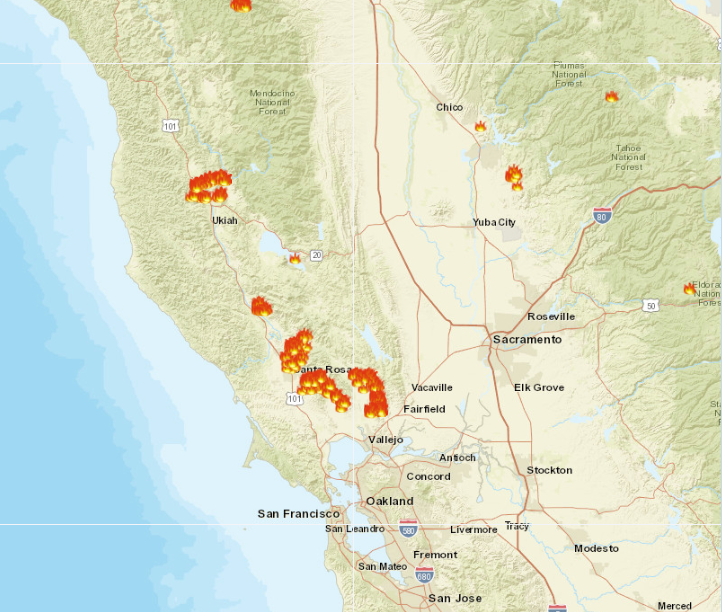
Update, October 9, 5:00 p.m. PDT: Multiple outlets are reporting the death toll from the northern California fires has risen to 10—seven in Sonoma County, two in Napa County. and one in Mendocino County.
Where are the fires?
Fourteen wildfires in eight northern California counties ignited late Sunday and early Monday, destroying at least 1,500 structures. The worst of the fires—the Tubbs and Atlas Fires in Napa and Sonoma counties—have spread to at least 50,000 acres and haven’t yet been contained, forcing the evacuation of 20,000 people. (Thousands have been evacuated in Orange County’s Anaheim Hills as well, where a fire erupted this morning.) California Governor Jerry Brown declared a state of emergency Monday morning in Napa, Sonoma, and Yuba counties, and the National Weather Service issued a red flag warning—its highest fire alert—across northern California and parts of southern California. The fires follow many over the last couple of months, including the largest brush fire in Los Angeles’s history. UCLA climate scientist Daniel Swain told the Los Angeles Times that the fires are “definitely edging up there into one of the worst clusters of fires in California history.”
One Twitter user took a screenshot of NASA’s heat data overlayed on Google Earth, to illustrate the fires’ spread:
Fires near "Santa Rosa" and Sonoma/Napa Valleys seen by satellite data "MODIS" from @NASA Greens/Red colors indicate more heat generation. pic.twitter.com/ckmSAF0nEf
— Casey Crosbie (@f12wedge) October 9, 2017
Who’s affected?
California has thousands of wildfires each year, but they’re often isolated to sparsely populated areas. Not this time.
The situation is most dire in the city of Santa Rosa, home to some 175,000 people 50 miles north of San Francisco. As the Tubbs Fire spread from nearby Calistoga toward Santa Rosa’s center, a large swath of the city’s northern and western ends—including two hospitals—were placed under a mandatory evacuation order (other parts of Sonoma and Napa counties have mandatory and voluntary evacuation orders as well). Just after 2 a.m., the fire leaped across six lanes of Highway 101 to Santa Rosa’s western half, reportedly destroying more parks and homes.
Kaiser Permanente Santa Rosa is now urgently evacuating patients as fire gets close to hospital. Live coverage: https://t.co/9yYmnyfQNe pic.twitter.com/G8IDp4mBIN
— Reggie Aqui (@reggieaqui) October 9, 2017
More than 100 people were treated for for injuries, including burns and smoke inhalation, though no deaths have been reported. (A fire further north in Mendocino County has resulted in two serious injuries and one fatality.)
Startling images of buildings engulfed in flames flooded social media this morning:
Santa Rosa's Hilton Sonoma hotel among dozens of burned businesses. #TubbsFire pic.twitter.com/tp8RZebSBw
— Kurtis Alexander (@kurtisalexander) October 9, 2017
Santa Rosa Kmart on Cleveland Ave fully engulfed. #TubbsFire pic.twitter.com/yWkmdW1No0
— Kurtis Alexander (@kurtisalexander) October 9, 2017
“(We) got the hell out of there”: Flames force @PGATOUR officials, players to flee Silverado after golf tourney. https://t.co/b6EAJOgeM4 pic.twitter.com/cjHzoX4BF0
— Sporting Green (@SportingGreenSF) October 9, 2017
Is climate change causing these fires?
We don’t know for sure. What we do know is that fall is typically fire season in northern California, when hot temperatures and dry, fast winds make for a combustible combination.
We also know that climate change can cause more frequent extreme weather events, which in turn can exacerbate the conditions that give rise to wildfires. While California saw an epic amount of rain last winter that ended its years-long drought, the past several months have been hot and dry. Last month, a heat wave drove record high temperatures across the Bay Area—including the highest temperature ever recorded in San Francisco since its weather station was established in 1874.
How’s the rest of the Bay doing?
Bay Area residents as far south as San Jose—which is about 60 miles from the fires—awoke to falling ash and the smell of smoke this morning. Many called the police, forcing some police departments to request that residents don’t call 911 unless they see unattended flames.
Anyone else smelling this fire smoke in south San Jose? I’m worried.. the smoke smell is getting stronger. 😩
— hannah bear ↯ (@_discobones) October 9, 2017
#napafire I’m in #SF , my org photo was a still but this is a iPhone live video of what I took. #BayArea pic.twitter.com/aSr43o1C4F
— Arturo Trujillo (@Turo420) October 9, 2017
The Bay Area Air Quality Management District issued a smoke advisory on Monday, warning that “the Bay Area is expected to exceed national health standards for particulate matter.” The EPA’s air quality map classified parts of the Bay as “moderate” to “unhealthy.”
GOES 16 satellite imagery showing North Bay areas covered in smoke as multiple fires continue to burn.#cawx pic.twitter.com/I6UXBtcjf4
— NWS Bay Area (@NWSBayArea) October 9, 2017
How are the vineyards doing?
The Napa and Sonoma County fires could devastate California’s massive wine industry. Three and a half million people visited Napa Valley last year, largely drawn by the region’s wineries. Quartz reports that the grape harvest season lasts through late October or early November, and that replanting just one acre of vines in Napa Valley costs between $15,000 and $25,000.
The San Francisco Chronicle reported similar threats to the burgeoning marijuana industry, which has as many as 3,000 cannabis gardens in Sonoma County. The Chronicle reports that, according to some analysts, an acre of cannabis is worth about $1.7 million.


